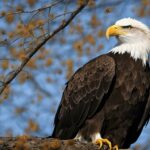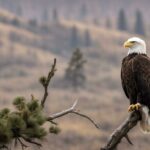Have you ever wondered whether hunting bald eagles is allowed? These majestic birds are a symbol of American pride and are protected by law. It’s important to understand eagle protection laws to ensure their conservation and avoid legal consequences.
Key Takeaways
- Bald eagles are protected species and hunting them is prohibited by federal and state laws.
- Violating eagle protection laws can result in fines and imprisonment.
- Contribution to conservation efforts and public support are crucial for protecting these birds for future generations.
Exploring Bald Eagle Protection Laws
If you’ve ever wondered whether you can hunt bald eagles, it’s important to understand the laws and regulations that protect these majestic birds. Bald eagles are a federally protected species under the Bald and Golden Eagle Protection Act, as well as a protected species in every state in the United States. This means that hunting, capturing, killing, or disturbing bald eagles in any way is illegal and can result in severe consequences.
| Federal law: | The Bald and Golden Eagle Protection Act (16 U.S.C. 668-668d) prohibits “taking, possessing, selling, purchasing, bartering, offering to sell, purchase, or barter, transporting, exporting or importing” bald eagles, as well as their parts, nests, or eggs, without a permit. |
|---|---|
| State law: | All states in the United States have laws that protect bald eagles, which may impose additional restrictions on hunting, capturing, killing, or disturbing these birds beyond federal regulations. Violating state laws can result in state-level fines and penalties, in addition to federal consequences. |
The consequences of violating bald eagle protection laws can be severe, including fines up to $250,000 and imprisonment for up to two years for individuals, and fines up to $500,000 for organizations. These penalties are in place to ensure the preservation of bald eagles and their habitats for future generations to enjoy.
Reporting illegal bald eagle hunting
If you witness or suspect any illegal bald eagle hunting activity, it’s essential to report it to the authorities immediately. You can report illegal hunting to the United States Fish and Wildlife Service or your state’s wildlife agency. Reporting such activities helps to protect these iconic birds and enforce the laws that safeguard them, ensuring their continued existence in the wild.
Recognizing Bald Eagles as Protected Species
Did you know that bald eagles are a protected species in the United States? These majestic birds have been listed as a protected species since 1940, and hunting them is strictly prohibited by federal and state laws.
The bald eagle is a symbol of strength and freedom, and its preservation is crucial to maintaining a healthy ecosystem. Bald eagles play a vital role in the food chain, and their presence indicates the overall health of an ecosystem. By protecting bald eagles, we protect the environment and ensure that future generations can enjoy these magnificent birds.
| Bald Eagles as a Protected Species | Conservation Efforts |
|---|---|
| Bald eagles are protected by several federal laws, including the Bald and Golden Eagle Protection Act, the Migratory Bird Treaty Act, and the Endangered Species Act. These laws prohibit hunting, killing, possessing, or disturbing these birds, their nests, or eggs. | Various conservation efforts have been put in place to protect the bald eagle population. These include habitat preservation, nest monitoring, and public education programs. Due to these efforts, the bald eagle population has made a recovery and is no longer considered endangered. |
It is essential to understand the laws and regulations that protect bald eagles. By recognizing their importance as a protected species, we can ensure their continued existence and maintain the balance of our environment.
Understanding Hunting Permits for Bald Eagles
If you are wondering whether hunting bald eagles is legal, the answer is a resounding no. Bald eagles are protected under federal and state laws in the United States, making it illegal to hunt them. However, there may be some confusion regarding hunting permits for bald eagles.
It is important to clarify that there are no hunting permits issued for bald eagles. These majestic birds are considered a protected species, and any attempt to hunt them is illegal and punishable by law.
It is crucial to understand and respect eagle protection laws to ensure the preservation of these iconic birds for future generations. If you come across any information suggesting that hunting permits are issued for bald eagles, it is essential to verify its accuracy and report any illegal activities to the authorities.
Penalties for Hunting Bald Eagles
Hunting bald eagles is strictly prohibited under federal and state laws. Anyone caught engaging in illegal hunting practices faces severe penalties, including fines of up to $100,000 and imprisonment for one year. Repeat offenders or those convicted of killing or injuring bald eagles face even harsher penalties, including fines of up to $250,000 and imprisonment for two years. Moreover, the Migratory Bird Treaty Act provides further consequences for violating bald eagle protection laws.
It is important to note that individuals can face criminal charges even if they did not intend to harm or kill a bald eagle. Accidentally shooting or killing a bald eagle, for instance, carries the same penalties as intentional hunting. As such, it is crucial for everyone to understand and respect the laws that protect these majestic birds.
Exceptions to Hunting Regulations
While bald eagles are protected under federal and state laws, there are exceptions to these regulations that allow for limited hunting in certain circumstances. These exceptions are strictly regulated and require special permits.
One such exemption is for scientific research purposes. Researchers may be granted permits to capture and handle bald eagles for the purpose of studying population dynamics, ecological relationships, and other scientific research. These permits are closely monitored and strictly regulated to ensure the safety and well-being of the birds.
Another exception is for Native American tribes that have traditional cultural practices that involve the use of bald eagle feathers and parts. These tribes may be granted permits to use feathers and other parts for religious and cultural purposes, following specific protocols and guidelines.
It’s important to note that these exceptions are highly specific and require extensive documentation and approval before any hunting or harvesting of bald eagles is allowed. Violating these regulations can result in serious legal consequences, including hefty fines and even imprisonment.
Reporting Illegal Bald Eagle Hunting
If you ever witness someone hunting a bald eagle or suspect illegal hunting activity, it’s crucial to report it immediately. Not only is it a violation of federal and state laws, but it also threatens the survival of these protected species. You can help protect these majestic birds by reporting any suspicious activity.
The first step in reporting illegal bald eagle hunting is to contact your state’s wildlife agency or the U.S. Fish and Wildlife Service. You can also report the activity anonymously through their tip lines. Make sure you provide as much information as possible, including the location, time of day, description of the individuals involved, and any other relevant details.
Your role as a citizen is crucial in protecting these magnificent birds. By reporting illegal hunting activity, you’re helping to ensure the survival of the bald eagle for future generations.
Conservation Efforts for Bald Eagles
Bald eagles are a protected species in the United States, and conservation efforts are crucial to ensuring their survival for generations to come.
One of the main conservation efforts for bald eagles is habitat preservation. Protecting and restoring natural habitats, such as wetlands and forests, provides crucial nesting areas and food sources for these birds.
Another important initiative is nest monitoring. Bald eagle nests are carefully monitored to track population trends and ensure the health and safety of both adult eagles and their young. This information helps guide conservation efforts and prevent disturbances to nesting sites.
Public education programs are also crucial in promoting the conservation of bald eagles. By increasing awareness and understanding of these birds, individuals are more likely to take action to protect them and their habitats.
Through these and other conservation efforts, the bald eagle population has made a remarkable recovery since being listed as an endangered species in 1967. Today, their numbers continue to grow, but the work to protect them is far from over.
Educating the Public on Bald Eagle Protection
As a citizen, you play a critical role in ensuring the protection of our national symbol, the bald eagle. Educating yourself and others on the importance of eagle conservation is the first step in promoting responsible behavior towards these magnificent creatures.
Learning about the laws and regulations surrounding bald eagle protection can help you to identify and report any instances of illegal hunting or harassment of these birds. By reporting such activities, you can help to ensure that those responsible are held accountable and that these birds are protected from harm.
Additionally, you can support conservation efforts through volunteering, donating, and participating in public awareness campaigns. By contributing to initiatives such as nest monitoring and habitat preservation, you can help to ensure that bald eagles have the resources they need to thrive.
Public education programs are also essential in promoting a culture of conservation and responsible behavior towards bald eagles. By learning about these birds and sharing your knowledge with others, you can help to inspire a new generation of eagle advocates who are committed to protecting these majestic birds for years to come.
Future Outlook for Bald Eagle Protection
The future looks bright for bald eagle protection and conservation efforts. These majestic birds are no longer on the endangered species list and have made a remarkable recovery since the 1970s. The bald eagle population in the continental United States has surpassed 10,000 breeding pairs, and their range has expanded to include many states where they were once absent.
However, there are still challenges ahead. The loss of habitat due to development and climate change remains a threat to bald eagles, and they can be impacted by pollutants such as lead and pesticides. Wildlife officials and conservation organizations continue to work on protecting and preserving bald eagle habitats and addressing these challenges.
Success Stories of Bald Eagle Conservation
Many success stories have emerged from bald eagle conservation efforts across the United States. In Wisconsin, for example, a partnership between the state wildlife agency and electric utilities led to the creation of nesting platforms on power poles, which has helped to boost the state’s bald eagle population. In Florida, the Audubon Society and other organizations have worked together to protect and manage bald eagle habitats, resulting in an increase in the bird’s population and range.
Other states, such as Minnesota and California, have seen similar successes. These stories demonstrate the power of collaborative efforts and highlight the potential for continued progress in bald eagle conservation.
Challenges Ahead for Bald Eagle Protection
Despite the many successes, there are still challenges that remain when it comes to protecting bald eagles. One of the biggest challenges is the loss of habitat due to human development. As more land is cleared for housing and commercial purposes, the remaining areas for bald eagle habitat become smaller and more fragmented.
Climate change is also a significant concern. As temperatures and weather patterns change, it can impact the bald eagle’s prey and nesting habits. Additionally, pollutants such as lead and pesticides can still pose a threat to bald eagles, even if they are no longer hunted.
The Importance of Continued Conservation Efforts
Despite the challenges ahead, it is critical that conservation efforts for bald eagles continue. The success stories from across the country demonstrate that these efforts are making a real impact. Continued conservation efforts can help to ensure that bald eagles remain a vital part of the American landscape for generations to come.
As an individual, there are many ways you can support bald eagle conservation. You can participate in local habitat restoration projects, report any instances of illegal hunting, and spread awareness about the importance of protecting these iconic birds. By working together, we can help to ensure that bald eagles continue to soar across the United States.
Public Support for Bald Eagle Conservation
As a concerned citizen, you can contribute to the conservation of bald eagles by becoming aware of the laws that protect them and helping to report any illegal hunting activities. However, there are also other ways in which you can support the cause and make a meaningful impact on the future of these majestic birds.
- Support local conservation organizations: Many non-profit organizations, such as the National Wildlife Federation, are dedicated to protecting bald eagles and their habitats. Consider making a donation or volunteering your time to support their efforts.
- Reduce your environmental impact: By making small changes in your daily life, such as using reusable bags or reducing your energy consumption, you can help to preserve the natural resources that bald eagles rely on.
- Spread awareness: Talk to your family, friends, and community about the importance of bald eagle conservation. By raising awareness and promoting a culture of responsible behavior towards these birds, you can help to ensure their protection for generations to come.
By working together and supporting each other’s efforts, we can make a meaningful impact on the future of bald eagles and the ecosystems in which they live. Let’s ensure that these magnificent birds continue to soar through our skies for generations to come.
Conclusion
So, can you hunt bald eagles? The answer is a resounding no, as bald eagles are a legally protected species in the United States.
Understanding eagle protection laws is crucial in preserving these magnificent birds. Violating these laws can result in severe legal consequences, including fines and imprisonment.
Conservation efforts, such as habitat preservation and public education programs, are essential in safeguarding the future of bald eagles. Reporting any illegal hunting activities is also crucial in protecting these iconic birds.
It is important to recognize the significance of bald eagles as a protected species and the role of citizens in preserving their populations. As public support for bald eagle conservation grows, we can ensure that these birds continue to soar in the skies for generations to come.
Are Cats a Natural Prey for Bald Eagles?
Cats are commonly regarded as agile predators, but when it comes to bald eagles and their mysterious prey, the situation is quite the opposite. While cats may fall victim to a range of threats in the wild, bald eagles seldom target them. These majestic birds tend to focus on larger prey, leaving cats to roam relatively safely in their territory.
FAQ
Q: Can you hunt bald eagles?
A: No, hunting bald eagles is strictly prohibited by federal and state laws in the United States. Bald eagles are protected species.
Q: What are the consequences for hunting bald eagles?
A: The consequences for hunting bald eagles are severe. Violating eagle protection laws can result in fines, imprisonment, and other legal penalties.
Q: Why are bald eagles protected species?
A: Bald eagles are protected species due to their significance to the environment and their populations being threatened in the past. Conservation efforts aim to preserve their numbers and habitats.
Q: Are there any exceptions to the hunting regulations for bald eagles?
A: There are limited exceptions to hunting regulations for bald eagles, such as scientific research or tribal practices. However, these exceptions are highly regulated and require specific permits.
Q: How can I report illegal bald eagle hunting?
A: It is crucial to report any instances of illegal bald eagle hunting. You can report such activities to local law enforcement agencies or wildlife conservation organizations to ensure appropriate action is taken.
Q: What conservation efforts are in place for bald eagles?
A: Various conservation efforts are in place for bald eagles, including habitat preservation, nest monitoring, and public education programs. These initiatives aim to protect and promote the well-being of these majestic birds.
Q: How can I contribute to bald eagle conservation?
A: You can contribute to bald eagle conservation by supporting and participating in local conservation initiatives, spreading awareness about their protection, and respecting eagle protection laws.
Q: What is the future outlook for bald eagle protection?
A: The future outlook for bald eagle protection is optimistic due to ongoing conservation efforts. However, challenges such as habitat loss and climate change still need to be addressed to ensure the long-term conservation of these birds.
Q: How can public support contribute to bald eagle conservation?
A: Public support plays a crucial role in bald eagle conservation. By advocating for their protection, supporting conservation organizations, and promoting responsible behavior, individuals can contribute to the preservation of these magnificent birds.










